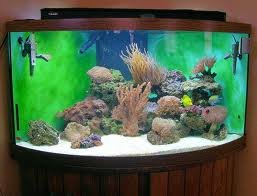Maintaining Your Aquarium
Maintenance is probably the most
important aspect of this hobby beyond choosing the proper equipment
and livestock.

You could do everything perfect in
choosing your tank, lights, livestock etc. but if you fail to perform
routine maintenance your livestock will end up living in their own
sewage.
So lets first determine what exactly is
maintenance. Well the short answer is cleaning your tank and
performing water changes. I will outline my take on basic
maintenance. This article will outline weekly, monthly, quarterly,
and yearly maintenance but just what I consider to be the basics as
every aquarium varies on equipment and waste production.
The tank:
I will use a basic Biocube 29 gallon
HQI tank with an added protein skimmer in chamber 2 for my example.
Daily Maintenance:
keeping these amazing creatures in our homes. Every aquarium and
equipment setup is different so the above steps are only one example
of a maintenance schedule. I hope this has at the very least gotten
you thinking about creating your own maintenance schedule. To me this
is the ground work for stability in an aquarium. Nothing good in this
hobby happens fast. It also rarely happens right the first time. As
your aquarium changes so will the required maintenance.

And you don't need to be a super hero to do it!
Maintenance is probably the most
important aspect of this hobby beyond choosing the proper equipment
and livestock.
You could do everything perfect in
choosing your tank, lights, livestock etc. but if you fail to perform
routine maintenance your livestock will end up living in their own
sewage.
So lets first determine what exactly is
maintenance. Well the short answer is cleaning your tank and
performing water changes. I will outline my take on basic
maintenance. This article will outline weekly, monthly, quarterly,
and yearly maintenance but just what I consider to be the basics as
every aquarium varies on equipment and waste production.
The tank:
I will use a basic Biocube 29 gallon
HQI tank with an added protein skimmer in chamber 2 for my example.
Daily Maintenance:
- Check water level in Chamber 3 and
top off as necessary. Keeping a stable water level will reduce
salinity fluctuation. The more stable this is the better for your
inhabitants. - Clean glass as needed. This step
is more for us than the inhabitants. After all we have our tanks so
we can enjoy them and that is really hard to do when we can't see
through the glass - Check all coral and fish. I do
daily accountability if a snail knocked over a coral it could damage
the coral or even kill it if not corrected. I also check and make
sure all fish are alive and well showing no signs of illness.
- change out filter media. This
ensures that the waste is collected and removed - Water change. This is probably one
of the most important maintenance steps on a nano aquarium. Most
nano aquariums lack the ability to process all the waste produced
through feeding and fecal matter. The reason for this is that even
though its a nano aquarium the majority of these aquariums are
grossly overstocked. The small water volume and lack of biological
media (rock,bio balls etc). - Empty skimmer cup and clean as
necessary. Its possible that this step could need to be done twice
in a weeks time that is dependent on the skimmers effeciency and the
available waste to be processed.
- Water testing. In my biocube I
stocked mainly soft corals and LPS. I did not have a high demand for
additives beyond that provided from weekly water changes. The
testing would always be done prior to my water change. - Blowing sediment from the rocks
nooks and cranneys. The good old turkey baster. Shooting the rocks
clean of debris will ensure that the pores don't plug up and they
continue to be a good biological filter method for you. If you allow
the sediment to cake into the rocks you will eventually have nitrate
isues or worse. - Water change. Yup I always did a
notably larger water change once a month. This allowed me the extra
water volume needed to vacuum the sand and rear chambers. This was
very important. No matter how good your filtration is you will
always get some sediment build up. Removing it is key to keeping the
nutrients from building up to harmful levels.
- Tear down pumps and do a thorough
cleaning. This ensures that they continue to work and hopefully
keeps them maintenance free for another year. - Change light bulbs. Metal halides
should be changed every 9 months. Just for reference T5HO lighting
is 9-12 months. Power Compact Flourescent lights 6-9 months and LED
has a life span of approximately 50,000 hours.
- This is also the time to make sure
you have all the emergency needs for the next year.. I know you
can't anticipate every emergency for a year but its a good idea to
have a few spare parts laying around in a closet. (extra light,
extra pump, extra heater etc. as your situation and wallet dictate) - On the emergency not this is the
time to test your emergency systems if you have any, i.e. battery
backups and generators etc.
keeping these amazing creatures in our homes. Every aquarium and
equipment setup is different so the above steps are only one example
of a maintenance schedule. I hope this has at the very least gotten
you thinking about creating your own maintenance schedule. To me this
is the ground work for stability in an aquarium. Nothing good in this
hobby happens fast. It also rarely happens right the first time. As
your aquarium changes so will the required maintenance.
And you don't need to be a super hero to do it!














